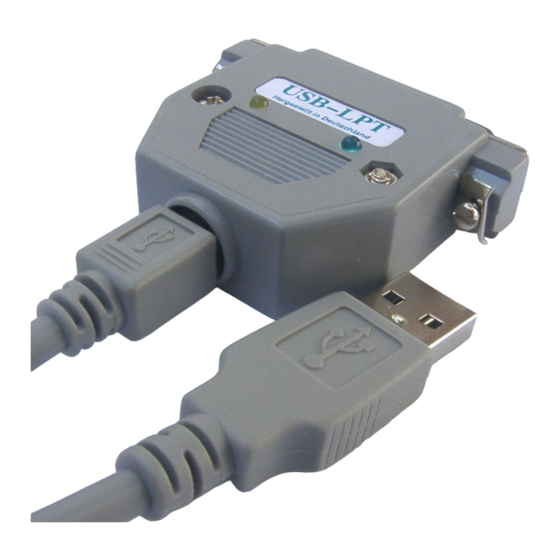
Table of Contents
Advertisement
Quick Links
Properties
•
Converter from USB to parallel port (25 pin SubD receptacle) with hardware
virtualization at input/output instruction level
•
Supports all parallel port modes named SPP, EPP and ECP, 16 Byte FIFO depth
•
USB High Speed (480 Mbit/s signaling; 8 kByte/s at input/output instructions)
•
Supports USB suspend mode with reduced power consumption
•
Multifunction device with extra USB to parallel printer support in accordance to
USB printer class specification
•
Full open-source, even for schematics and PCBs
System requirements
•
PC or notebook with a free USB socket; maybe over an external USB hub
•
Microsoft Windows 98, Windows Me, Windows 2000, XP, Vista, Windows 7
(registered trademarks of Microsoft Corp., Redmond, Washington, U.S.A.)
•
Parallel-port software with "well-behaved" accesses to parallel port, usually with a
user-selectable port address
Windows 95 is not suitable. For Linux, someone should adopt (i.e. re-write) the driver.
DOS programs are supported too.
For unknown reason there are limitations when using USB2LPT on Windows XP or Vista.
These limitations are described below.
USB2LPT almost never work with software protection devices ("dongles"). The reason is that
dongle driver software usually prevents trapping of parallel port accesses, to make cracking
the dongle more difficult.
USB to parallel converter
USB2LPT
Versions 1.2, 1.3, 1.4, 1.7 (High-Speed)
Installation Manual
1
Advertisement
Table of Contents

Summary of Contents for Henrik Haftmann USB2LPT
-
Page 1: System Requirements
Windows 95 is not suitable. For Linux, someone should adopt (i.e. re-write) the driver. DOS programs are supported too. For unknown reason there are limitations when using USB2LPT on Windows XP or Vista. These limitations are described below. USB2LPT almost never work with software protection devices (“dongles”). The reason is that dongle driver software usually prevents trapping of parallel port accesses, to make cracking the dongle more difficult. - Page 2 For more information and sources, visit the web page http://www.tu-chemnitz.de/~heha/bastelecke/Rund um den PC/USB2LPT/index.htm.en Plug the device Plug the USB2LPT device with the accompanying cable, preferrable to that USB socket where you want use the device later. yellow LED lights up, and flashes on any USB activity.
- Page 3 Click “Specify a location” to select the folder where you have unpacked the downloaded file usb2lpt.zip – oder leave “Floppy disk drives” checked if you have a diskette. Use the two-letter language directory (e. g. en for English) you prefer. Currently, 11 languages are available.
- Page 4 Make more settings Open Device Manager, and locate the three entries for the USB2LPT device, as shown below. Error, on Windows XP, Vista, and Windows 7: Independently of current parallel port assignment, always LPT3 is shown. In general, USB2LPT is assigned to the next free parallel port name (usually LPT1). Displaying the...
- Page 5 (as shown in the title bar). Most software ignores the port name. Settings not known by the user should be left unchanged. Important to know: Windows saves these settings separately for every USB socket. Therefore, if you change the socket where you plug the USB2LPT, you must repeat this setting change.
- Page 6 Now advance by clicking on tab „Statistics“, and let stay this property sheet open and visible. So you have an idea how and when USB2LPT works. Connect your hardware to the 25 pin SubD receptacle of USB2LPT converter, start your software, and observe the counters. Best action is counting at “READ/WRITE_PORT_UCHAR redirection”.
- Page 7 To save trouble, use always the same USB socket when using the USB2LPT device. Now use your software, as you have a real parallel port. Whether your software is already checked to run with USB2LPT, or you have to make some special precautions, please read the following web page: http://www.tu-chemnitz.de/~heha/bastelecke/Rund um den PC/USB2LPT/liste.htm.en...
- Page 8 This program doesn’t work on Windows XP. Pretty please, use another Windows (even Windows 95, Windows 3.1 is suitable). Recycling Send the device and the USB cable back to the following address: Henrik Haftmann Riesaer Straße 25c 01665 Nieschütz Germany The package must be sufficiently paid by sender.
Need help?
Do you have a question about the USB2LPT and is the answer not in the manual?
Questions and answers